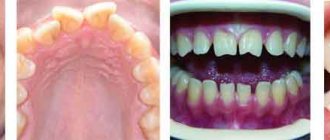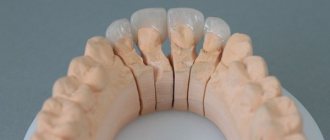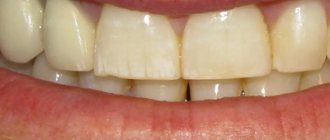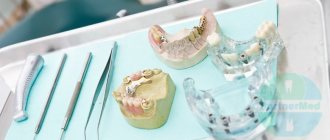Composite veneers – how are they better than composite veneers? Their main features and advantages
Componeers are thin restoration linings that are fixed on the front side of the teeth in order to hide visible defects and make a smile beautiful and snow-white. Essentially, these are the same veneers, but with some fundamental differences. For example, these plates are based on a special material – a nanohybrid composite, and the patent for the development of the technology for its creation belongs to the Swiss company Coltеne/Whaledent AG. Read more about what componers are and how exactly they are attached to teeth, as well as the difference between these and other types of restoration onlays further in this article.
Indications and contraindications for installation
Componeers are the same as composite veneers, but a special type of composite material is used to create them. This is a special nanohybrid composite, which due to polymerization becomes more resistant to mechanical loads. The composition also contains ceramic filler. All this makes the finished material less porous, and therefore more reliable and durable1. As a result, microprostheses are wear-resistant, and their service life is noticeably increased.
Componeers – thin restoration overlays
It should also be noted that we are talking about ready-made overlays. The material is not applied to the teeth in layers, but the plates are fixed during one visit. There is a fairly wide range of models from which the patient, together with a specialist, selects products of a suitable shape and color. During the installation process, the doctor only adjusts the composite to the anatomical features of each incisor and canine.
Among the indications for this method of restoration, experts in the field of dentistry include the following cases:
- change in the color of one incisor or a group of teeth falling within the smile zone,
- slight curvature of incisors and canines, for example, due to crowding,
- darkening of fillings in the front part of the jaw,
- tetracycline teeth - discoloration of crowns due to taking antibiotics of the tetracycline group,
- chips and microcracks,
- large interdental spaces – trema and diastema,
- thinning of the enamel and its increased sensitivity - hyperesthesia,
- pathological abrasion of enamel,
- the patient’s desire to become the owner of a beautiful snow-white smile.
Indications for use may be darkened teeth
“For as long as I can remember, I have always been terribly embarrassed to smile. The front teeth were slightly crooked, and no matter how much I brushed them, they did not become white, although they were healthy, strong, and there was never even much caries. They are like this from birth, unattractive. Therefore, at 27 years old, I decided to get veneers. When I went to the doctor, he told me that there are different options and recommended componeers. In the end, I did everything in one visit, but I’ll say right away that the procedure is not quick. I'm very pleased with the result! Now I smile widely and boldly!”
Selena G., from correspondence on the 32top.ru forum
However, there are a number of contraindications in which experts recommend refusing to install componers. Such cases include bruxism, that is, involuntary clenching of the jaws and grinding of teeth, mainly during sleep. Also, it will not be possible to fix the plates on severely damaged teeth or if there are serious malocclusions. Before restoration, it is imperative to undergo a professional procedure. hygiene to remove plaque, supra- and subgingival deposits.
Installation steps with video
The procedure time depends on the number of teeth that are covered with onlays. Installation takes place in one session, but in several stages. There are 4 steps in total:
- Dental treatment and professional cleaning.
- Selection of color and shape of the composition.
- Preparation of the patient's teeth for installation of onlays (sometimes this stage is skipped).
- Fixation of composites using special material.
The difference between veneers and composites during the installation process is quite large. The creation and fixation of veneers takes much longer and will require several visits to the dentist.
What are the good things about componers and what are their disadvantages?
One of the main advantages of this restoration method is its relatively affordable cost. Unlike veneers and even more so lumineers, componeers cost patients much less. Other obvious advantages of this type of lining include the following:
- high aesthetics - according to reviews from patients and experts, you can choose the color of the material that will exactly match the natural color of the enamel of adjacent teeth. In addition, with the help of such restoration plates you can easily disguise minor external flaws, adjust the shape and shade of incisors and fangs,
- a wide selection of finished products - yes, these are template plates, but they are presented in a wide range where you can find any shape and suitable shade,
- quick results - installation is carried out in just one visit, without first taking impressions and waiting for the products to be ready,
- additional protection of the enamel - like veneers and lumineers, compositers provide a kind of protective barrier from external influences, including mechanical, temperature and chemical factors,
- possibility of repair - if a chip appears, the integrity and aesthetics of the componer can be restored using a direct method, and for this it is not at all necessary to completely replace the plate,
- there is no need for frequent polishing - while classic composite veneers quickly lose their vibrant shine and become dull, this does not happen with composite veneers. They do not need to be polished every six months to maintain their original aesthetic appearance.
One of the main advantages of the products is considered to be high aesthetics and relatively affordable cost
. As for the disadvantages, it is worth mentioning the relative durability of the products. The material itself was introduced only in 2011, so there is simply no confirmed clinical data on the actual service life of compositors.
Veneers, componeers
A beautiful snow-white smile is an integral part of the attractive image of a modern person. As dentistry develops, methods for restoring their function and aesthetics that are more gentle on the hard tissues of teeth appear. One of these methods is the installation of veneers and composites.
Veneers
Dental veneers are microprostheses made of ceramics or photopolymer composite materials that are used for teeth in the smile area. Unlike crowns, they do not cover the entire tooth, but cover only the front surface and, in some cases, the incisal edge. Thus, the teeth acquire an even appearance and a beautiful color. Typically, the thickness of veneers is 0.5-0.6 mm, but there are also ultra-thin overlays with a thickness of only 0.3 mm.
Types of veneers
Veneers come in two varieties based on the manufacturing method - therapeutic (direct) and orthopedic (indirect). The first ones are made from light-curing filling material directly in the oral cavity. This type of microprosthesis provides good aesthetics, because the color range of modern composites allows you to choose almost any shade.
The restored tooth is no different from its neighbors. However, the color stability of direct dental veneers leaves much to be desired, since filling materials lose their shine and darken over time. In addition, the service life of composite veneers is very short.
Orthopedic microprostheses are made of metal-free ceramics. Its use allows you to accurately imitate natural teeth. Other advantages of these products are high reliability (their service life is at least 10 years and is mainly limited only by extreme circumstances, for example, injuries) and color fastness. The only drawback is the high cost of ceramic veneers. The physical properties of ceramics used for making veneers are very close to those of tooth enamel.
Contraindications for making veneers
Dental veneers cannot be installed in the following cases:
- pathological abrasion of teeth of the second degree and higher;
- significant destruction of the inner surface of the tooth;
- direct or reverse bite;
- absence of sixth or seventh chewing teeth;
- dental treatment with resorcinol-formalin in the past;
- the presence of a large filling on the back surface of the tooth;
- bruxism and some bad habits (opening bottles with teeth, biting off threads, etc.);
- extreme lifestyle of the patient (risk of injury).
A relative contraindication for installing veneers in dentistry is insufficient enamel thickness. Normally, the enamel layer on the front surface of the tooth should be more than 0.5 mm, so when preparing for prosthetics it is not completely removed. And if dental veneers are fixed to the remaining enamel, they will stick better than those attached to softer dentin.
Indications for making veneers
- change in tooth color due to incompletely performed endodontic treatment;
- tetracycline teeth;
- hypoplasia and other congenital dental defects;
- amelogenesis imperfecta;
- fluorosis;
- erosion of tooth enamel;
- extensive wedge-shaped dental defects;
- increased tooth wear;
- class III caries;
- demineralization of enamel that occurred after orthodontic treatment;
- too close position of the upper central incisors;
- irregular shape of teeth or their rotation along the axis;
- diastema and trema.
With proper care, compliance with hygiene rules, and periodic dental examinations, veneers can last more than ten years. After restoring the aesthetics of your teeth, it is not advisable to chew seeds and nuts, or eat solid foods. Experienced dentists recommend following the “rule of two”: performing hygienic oral care at least twice a day, undergoing a professional examination. Examination by a dentist at least twice a year and similarly, have your teeth professionally cleaned. By following simple rules, you can delight others with a healthy smile for a long time.
Componeers
Componers are used for cosmetic and restoration purposes. They can be adjusted at any time as desired and according to the individual characteristics of the patient using a composite.
Their main difference from veneers is that these are ready-made enamel onlays that combine the advantages of direct photopolymer composite restoration with the advantages of veneers made in a dental laboratory.
Componers are used in cases where:
- the color of one of the teeth is significantly different from the others in this row;
- there is an unnatural position of the dental units in a row: creeping on top of each other, reversals and other defects;
- there are irregularly shaped teeth;
- it is necessary to camouflage fillings that differ in color from natural tooth enamel;
- Restoration of chips is recommended;
- to eliminate gaps between teeth;
Unlike indirect porcelain veneers, compositers can be installed in one dental visit. The technology for selecting and installing compositors has been significantly reduced due to several factors, namely:
- preparing the oral cavity for restoration is less labor-intensive;
- the process of selecting the shade and shape of the material for the teeth being restored is noticeably easier and takes place with the participation of the patient himself;
- There is no procedure for taking an impression;
- no dental technician or laboratory equipment required
Even for the restoration of several units of teeth using composite materials, one visit to the patient will be enough for the dentist.
Most often, when installing composites, you can strengthen them without using tooth preparation. Even if such a procedure is necessary, it is carried out under the most gentle conditions possible. Installation of compositors to create an ideal central line is offered from two central teeth. When installing compositors, this is the most difficult job, taking approximately an hour and a half. The stage of preparation of hard tooth tissues during restoration using this method is practically absent, therefore hard tooth tissues are completely preserved.
Contraindications for installing compositors:
- violation of contact between the upper and lower rows of teeth (occlusion);
- consequences of parafunction of the masticatory muscles (teeth abrasion due to bruxism);
- insufficient oral hygiene;
- inflammatory periodontal diseases;
- significant area of destruction of hard dental tissues
Disadvantages of compos:
- limited ability to eliminate single defect defects;
- Composers only mask bite defects; deformities can be radically corrected only with the use of orthodontic techniques;
- with a significant area of restoration of the teeth of the upper row, it is necessary to resort to bleaching of the lower row or coating with the same composites.
Once componers are installed, reasonable caution should be exercised when consuming excessively hard foods. Even though componeers are made of durable material, they can also chip like any filling or veneer.
In this case, restoring the componer is not a particular problem. In the event of a chip, the lost part is restored using composite material or complete replacement. One visit to the dentist is enough, and your smile will become dazzling again, and the color of the new composite will be an exact copy of the previous one.
Preparing to fix the overlays
It is imperative to prepare for restoration. If there are carious cavities, they will need to be filled. If there have been fillings in the smile area for a long time, they may need to be replaced with new ones. Another important condition is to undergo the procedure of Prof. hygiene. Before installing onlays, you need to remove plaque and tartar.
Before the installation procedure, a prof. dental hygiene
How to install components
To begin with, the doctor, together with the patient, selects the shape and color of the plates. To do this, the specialist fixes the onlays on the teeth one by one, using a temporary adhesive. After the final decision is made, the teeth are polished and turned. In some cases, preparation can be avoided, but most often the crowns still have to be prepared.
The doctor removes a thin layer from the frontal surface, cutting edge and spaces between the incisors, and also forms the gingival margin. Only after this is the composite fixed, for which the specialist uses a special composite solution. And so, by analogy, he restores each subsequent tooth.
The overlays are fixed to a special composite
Rules for caring for teeth after installation of veneers
Despite the fact that the material is quite strong and wear-resistant, in the future it is better for the patient to maintain a high level of hygiene and try to avoid mechanical damage. There are no dietary restrictions, but you should still be careful when biting off hard foods with your front teeth. Experts recommend stopping chewing seeds and cracking nut shells with your teeth. All this can lead to chips and cracks in the plates.
Experts recommend stopping chewing seeds
Otherwise, the principles of hygiene are no different from the standard ones, but they should be observed with increased responsibility: brush your teeth every morning and evening, use floss and rinse your mouth after every meal, limit the consumption of sweets, carbonated drinks and coloring foods, and also visit the dentist for preventive care at least twice a year.
1According to information presented at the office. developer website: coltene.com.
Patient reviews
I've been wearing componeers for a year now. At first I was very afraid to put them on, because I didn’t really know anything about this technique. I was surprised that the doctor restored all my teeth in just one visit. During their operation, I did not identify any disadvantages. Unlike the installation of ceramic veneers, the price of this procedure is reasonable.
Valeria
Before agreeing to install composite veneers, I read many patient reviews and forums about composite veneers. I don’t regret my decision, since the procedure is quite quick and not as expensive as installing ceramic veneers or lumineers. The main task was to improve the aesthetic appearance, and the doctor chose the right shade of the overlays. The smile looks quite natural.
Maria
For a very long time I thought about what would be the best choice: regular veneers or composites.
I decided to try Componeer. The installation process took only 4 hours. I've been wearing them for a year and a half now. One of the onlays came off, but they quickly replaced it with a new one; its color is no different from the rest of my teeth. I was very pleased with the price of the componeers. Anastasia










